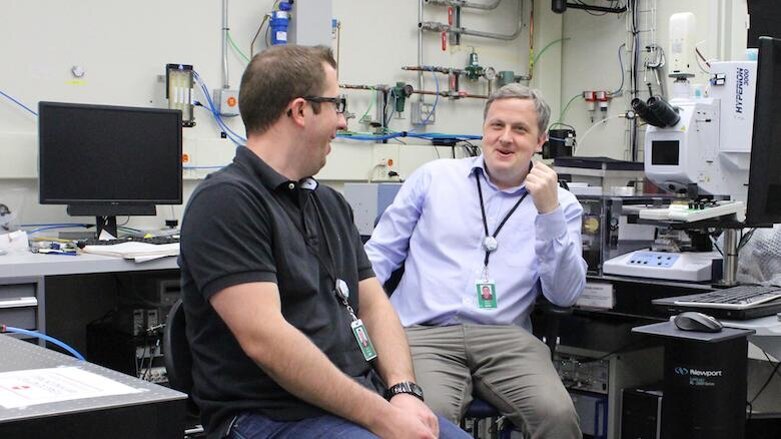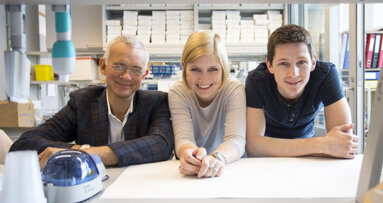EDMONTON, Alberta, Canada/LONDON, U.K.: Given that more than 2.3 billion people are estimated to suffer from dental caries, any potential advances in dental filling material could benefit a large proportion of the world’s population. By investigating the structure of certain composite materials, an international team of researchers has discovered a method that may well improve these materials and subsequently lead to stronger dental fillings.
The researchers, who are from Canada, the U.K., Norway and the U.S., set out to understand more about photoactivated resin-based composites, which are commonly used in a variety of medical and dental situations, including as a material in dental fillings. Though much is known about the chemical formulation of these composites, the way in which filler particles affect their polymerization has been poorly understood to this point.
To help close this knowledge gap, the research team employed wide-field mid-infrared imaging at the University of Saskatchewan’s Canadian Light Source, a synchrotron light source facility, to closely examine the behavior occurring within the matrices of various composites. By doing so, the researchers were able to demonstrate that added filler particles modify the reaction of these composites when setting.
Prof. Owen Addison, adjunct professor of dentistry at the University of Alberta and chair of oral rehabilitation at King’s College London’s Faculty of Dentistry, Oral and Craniofacial Sciences, was the lead author of the study. He told Dental Tribune International that this discovery could inform predictive models of composite material behavior and may improve the performance of the materials.
“These findings help dental practitioners in two ways,” Addison said. “Directly, they provide a new form of evidence that strengthens the argument that current resin composites are highly sensitive to photo-curing regimens and that dentists must recognize that adherence to recommended protocols is a must. Indirectly, this new approach will be a valuable tool to help guide the development of new generations of photo-cured composites.”
Addison further stated that these findings are part of an ongoing research project that will continue to develop these methods. “Over the next 12 months, we will also explore new approaches to optimize polymerization of the composite at interparticle length scales,” he added.
The study, titled “Origin of micro-scale heterogeneity in polymerisation of photo-activated resin composites,” was published online on April 15, 2020, in Nature Communications, ahead of inclusion in an issue.
Tags:
OULU, Finland: Dental fear is one of the most common fears in developed countries. Globally, the overall prevalence in children and adolescents is estimated...
BERGEN, Norway: Researchers from the University of Bergen have found that a rare autoimmune disease called autoimmune polyendocrine syndrome Type 1 (APS-1) ...
MALMÖ, Sweden: A forward thinking, transdisciplinary oral health research hub at Malmö University has received a welcome funding injection from ...
GOTHENBURG, Sweden: Though its causes can be unclear and multiform, the effects of dental anxiety in patients are well understood. As it increases, patients...
JÖNKÖPING, Sweden: Sweden has too few dentists in 18 of its 21 regions, and this is expected to continue until at least 2035. To close this gap, ...
UMEÅ, Sweden: Orofacial pain, including pain associated with temporomandibular disorder (TMD), is a common chronic condition, affecting 10%–15% of the ...
MALMÖ, Sweden: For the fifth year running, the Eklund Foundation for Odontological Research and Education is offering a number of grants to help fund ...
COPENHAGEN, Denmark: Known for its commitment to providing cutting-edge and market-leading dental solutions, 3Shape also prides itself on guiding and ...
COPENHAGEN, Denmark: As the realm of digital dentistry continues to evolve, offering unprecedented opportunities for enhanced patient care and practice ...
OSLO, Norway: Researchers have recently investigated attitudes and activities among dental healthcare professionals working in the public dental service ...
Live webinar
Wednesday, 14. January 2026
18:00 CET (Oslo)
Dr. Théo Laplane, Dr. Robert Gottlander DDS
Live webinar
Friday, 16. January 2026
18:00 CET (Oslo)
Live webinar
Monday, 19. January 2026
19:00 CET (Oslo)
Philipp Kopp, Michael Seeber
Live webinar
Thursday, 22. January 2026
15:00 CET (Oslo)
Prof. Judith Jones D.D.S; M.P.H., Prof. Kakuhiro Fukai D.D.S., Ph.D, Dr. Bathsheba (Bethy) Turton
Live webinar
Thursday, 22. January 2026
20:00 CET (Oslo)
Dr. Nicola M. Grande DDS, PhD
Live webinar
Wednesday, 28. January 2026
14:00 CET (Oslo)
Live webinar
Wednesday, 28. January 2026
17:00 CET (Oslo)
Prof. Dr. Jan-Frederik Güth



 Austria / Österreich
Austria / Österreich
 Bosnia and Herzegovina / Босна и Херцеговина
Bosnia and Herzegovina / Босна и Херцеговина
 Bulgaria / България
Bulgaria / България
 Croatia / Hrvatska
Croatia / Hrvatska
 Czech Republic & Slovakia / Česká republika & Slovensko
Czech Republic & Slovakia / Česká republika & Slovensko
 France / France
France / France
 Germany / Deutschland
Germany / Deutschland
 Greece / ΕΛΛΑΔΑ
Greece / ΕΛΛΑΔΑ
 Hungary / Hungary
Hungary / Hungary
 Italy / Italia
Italy / Italia
 Netherlands / Nederland
Netherlands / Nederland
 Nordic / Nordic
Nordic / Nordic
 Poland / Polska
Poland / Polska
 Portugal / Portugal
Portugal / Portugal
 Romania & Moldova / România & Moldova
Romania & Moldova / România & Moldova
 Slovenia / Slovenija
Slovenia / Slovenija
 Serbia & Montenegro / Србија и Црна Гора
Serbia & Montenegro / Србија и Црна Гора
 Spain / España
Spain / España
 Switzerland / Schweiz
Switzerland / Schweiz
 Turkey / Türkiye
Turkey / Türkiye
 UK & Ireland / UK & Ireland
UK & Ireland / UK & Ireland
 International / International
International / International
 Brazil / Brasil
Brazil / Brasil
 Canada / Canada
Canada / Canada
 Latin America / Latinoamérica
Latin America / Latinoamérica
 USA / USA
USA / USA
 China / 中国
China / 中国
 India / भारत गणराज्य
India / भारत गणराज्य
 Pakistan / Pākistān
Pakistan / Pākistān
 Vietnam / Việt Nam
Vietnam / Việt Nam
 ASEAN / ASEAN
ASEAN / ASEAN
 Israel / מְדִינַת יִשְׂרָאֵל
Israel / מְדִינַת יִשְׂרָאֵל
 Algeria, Morocco & Tunisia / الجزائر والمغرب وتونس
Algeria, Morocco & Tunisia / الجزائر والمغرب وتونس
 Middle East / Middle East
Middle East / Middle East
















































To post a reply please login or register